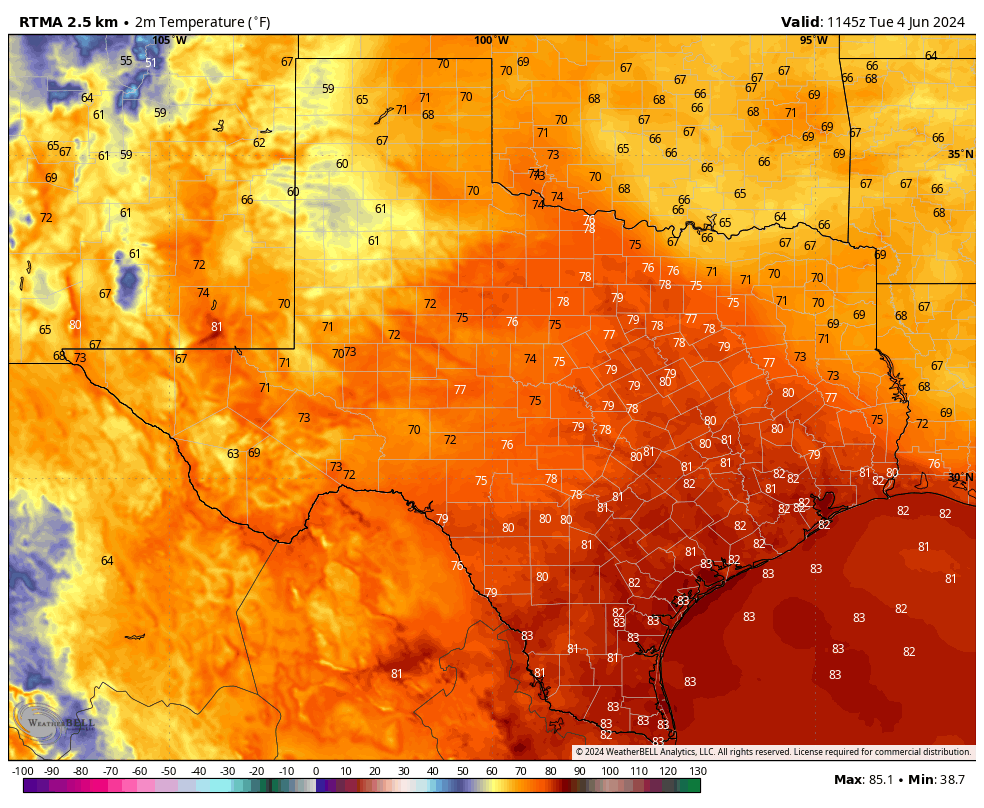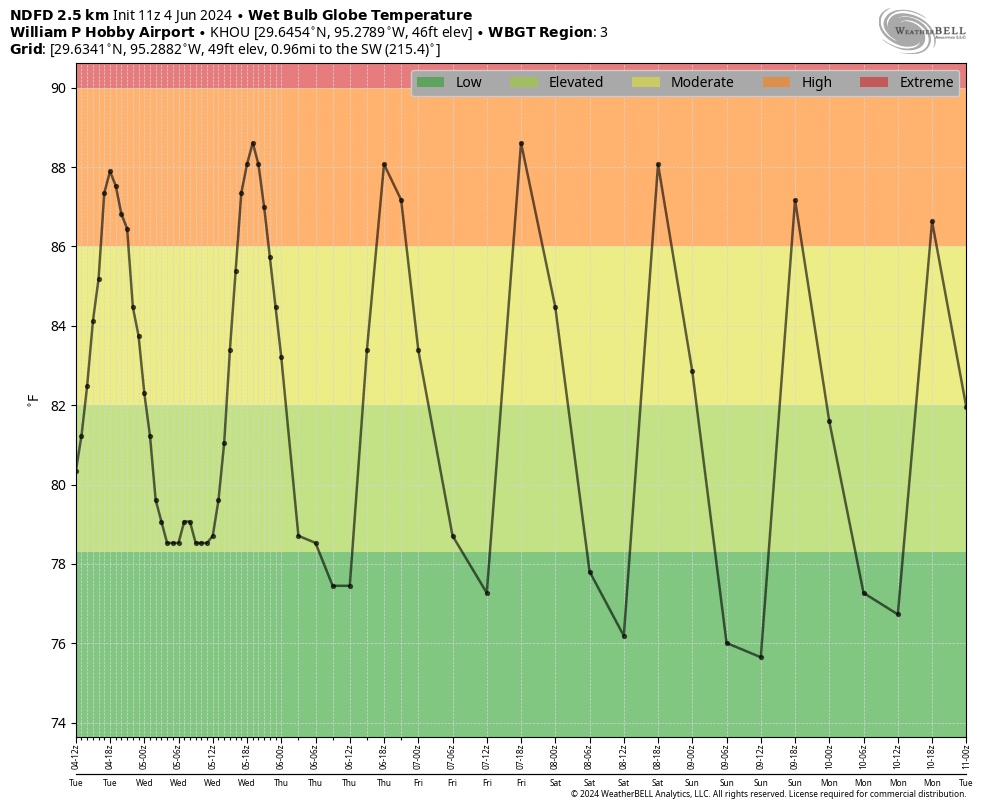In brief: Houston will continue to see some spotty rain chances the next couple of days before hotter and sunnier weather sets in for the end of the week and the weekend. Do you like temperatures in the mid-90s with lots of sunshine? Then you’re in luck. In this post we also discuss the rise of AI-based weather forecasting.

AI and weather forecasting
You’ve probably tried out ChatGPT or some of the other large language model-based artificial intelligence products that have come out in recent years. The basic premise of this technology is that they voraciously consume data to improve answers to queries. The more and higher quality data, the better their training, and the sharper the results. Well, when it comes to weather there is also a lot of historical data. Many decades of it, in fact, in datasets such as Europe’s ERA5 reservoir.
In the last couple of years, computer scientists have gotten serious about using this data to train AI models to forecast the weather in 2022. (These models have some basic similarities to large language models, but are distinctly different). Since then, the technology has made rapid strides. In some cases, the output of these models is already superior to physics-based global weather models that scientists have labored decades to design and build, and which require some of the most powerful supercomputers in the world to run.
Why do I bring this up? Because for the first time some of these models appear to be ready for prime time for the Atlantic hurricane season. And one of the things they seem to do really well is to predict the track of hurricanes. So Matt and I may be referring to them from time to time as part of our forecasting process. We’ll be evaluating them alongside the traditional, physics-based models. If you want to know more about all of this, I recently wrote a feature about AI weather forecasting for Ars Technica.
Speaking of hurricane season, things still look quiet for at least the next week or so. We’ll be providing regular coverage of Atlantic based activity on our companion site, The Eyewall again this year. Don’t worry, nothing will change here at Space City Weather. In any case, Matt has some more information about our plans for The Eyewall in 2024 here, including sponsorship opportunities, if you’re interested in what we’re doing beyond Houston.
Tuesday
We’re seeing a few showers near the coast this morning, but these should end fairly soon. For the most part, today, we should see a mix of sunshine and clouds with high temperatures in the low 90s. The most notable feature today may be the winds, which look to be fairly gusty from the south, reaching about 25 mph or a bit higher this afternoon. Rain chances are about 10 percent, or less, with a slight chance of severe storms along and north of Highway 105. Low temperatures tonight will only fall to about 80 degrees.

Wednesday
Tomorrow morning looks a little more interesting, in terms of rainfall, as a storm system drops down from the north around sunrise. This may produce some scattered showers during the morning commute in Houston, but it’s also possible that most of the rainfall stays to the east of Houston, over places like Beaumont. In any case, I don’t think we’ll see much in the way of severe weather. Some additional rain showers could develop during the late afternoon or early evening hours, with daytime heating. Again, chances look spotty. Most of the area probably has about a one-in-three chance of seeing rain, or less. Otherwise, expect partly sunny skies with high temperatures in the mid-90s.
Thursday and Friday
As high pressure expands into Houston these look to be mostly sunny days, with highs in the mid-90s. Daily rain chances are about 10 percent.
Saturday and Sunday
The weekend looks to bring continued hot and sunny weather, with highs in the mid-90s. Once again rain chances won’t be zero, but they’ll be close to it. With slightly drier air we may see nighttime temperatures falling into the mid- to upper-70s. We’re approaching the time of the year when the sunshine reaches its highest point in the sky, so please protect your skin when outdoors between the hours of 10 am and 4 pm.
Next week
We may be looking at some sort of pattern change next week, with some slightly drier air or better rain chances. What this all means for our weather is not quite clear to me yet, but I do think we’re likely to go back toward the lower 90s rather than remain on an upward trend in temperatures.

I really do enjoy these chances for short rain showers almost every day.
I’m excited to see the capabilities of the AI model analytics. There is so much detail about local areas that can be inferred from the historical data. Hyper local information becomes increasing difficult to model with physics due to the shear amount of data required (and corresponding compute) and even then that data probably doesn’t exist at the small scale to correctly model it. I’m glad y’all are diving in head first but also still keeping a solid basis in what you already know!
Re: Your article on AI.
WOW !
Spike
I truly hope we can get that cool front next week and maybe a wetter pattern as we head into Late June and July. I don’t want 4 months of August again with heat index’s of 110+ every day and no rain.
I read the article you wrote on AI. That is simply amazing. In comparison, the AI for weather forecasting and patterns compared to what has been a great system is like the technology and the computing needs that were in play during the moon landing in the late 60’s compared to what could probably be done with an iPhone.
Very rowdy in Galveston
Siding blowing off a few houses
Plywood chair blown into our yard.
50 mph gusts for sure.
Please answer a question. Lately I was with a group of very respected businessmen. Not sensationalists or survivalists. But they all were discussing the “contrails” and how jets can seed the air and cause weather disruptions…the claim that numerous contrails were seen before our big derecha was mentioned.
Is that technology even available to “seed the sky”
Can it cause weather disruption?
Is it all nonsense?
I would have asked them if they are aware that contrails go back to the early days of aviation.
I wonder if these “respected businessmen” have been hanging out with my Eastern Bloc former neighbor. She was also convinced planes controlled the weather and that government planes, in fact, caused Harvey. Because…she saw planes before Harvey and other major weather events. Never mind that there are always planes in the sky. Never mind that the government takes a huge financial hit in disaster payouts when major events occur…
Jokes about communism aren’t funny unless everyone gets them…
Weather disruption is not nonsense. Cloud seeing is a thing. Been around a while.
DOD put out a document in 1996 – ‘Weather as a Force Multiplier: Owning the Weather in 2025’.
It talks about weather modification and its application to military operations, ionospheric modification opportunities & much more. Degrading enemy forces via precipitation enhancement, stuff like that. Easy to find. These ideas are not new.
Not saying this is happening but hey, the DOD did put it out there.
“Is it all nonsense?”
You already know the answer to that.
BTW, who made them ‘very respected’?
If the AI trains not only on historical data but also on past forecasts, then implicitly it is at least partially relying upon the physics-based models. I hope there is still some value in trying to model the real world, rather than basing forecasts solely on what happened in the past.
I’m curious if we’ve tested AI by loading all sorts of data into the system and then ask it to predict something that has already happened to see how close it got. For example, have we loaded all the data you mention into an AI say from beginning of recorded to 2022 and then ask it to predict 2023 and see how close it got to what actually happened?
I was on the bay this morning and the wind was gusting to 46 knots at the Galveston jetties. That’s about 53 MPH. Continuing the trend of “overperforming” storms lately…